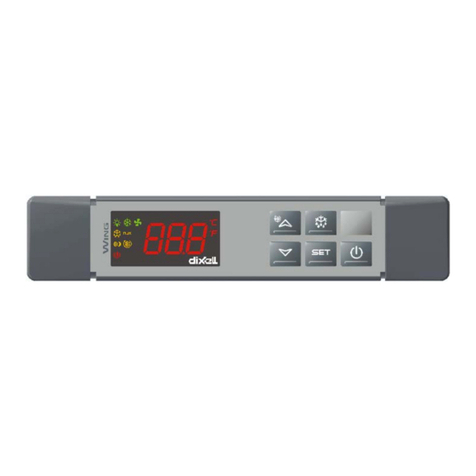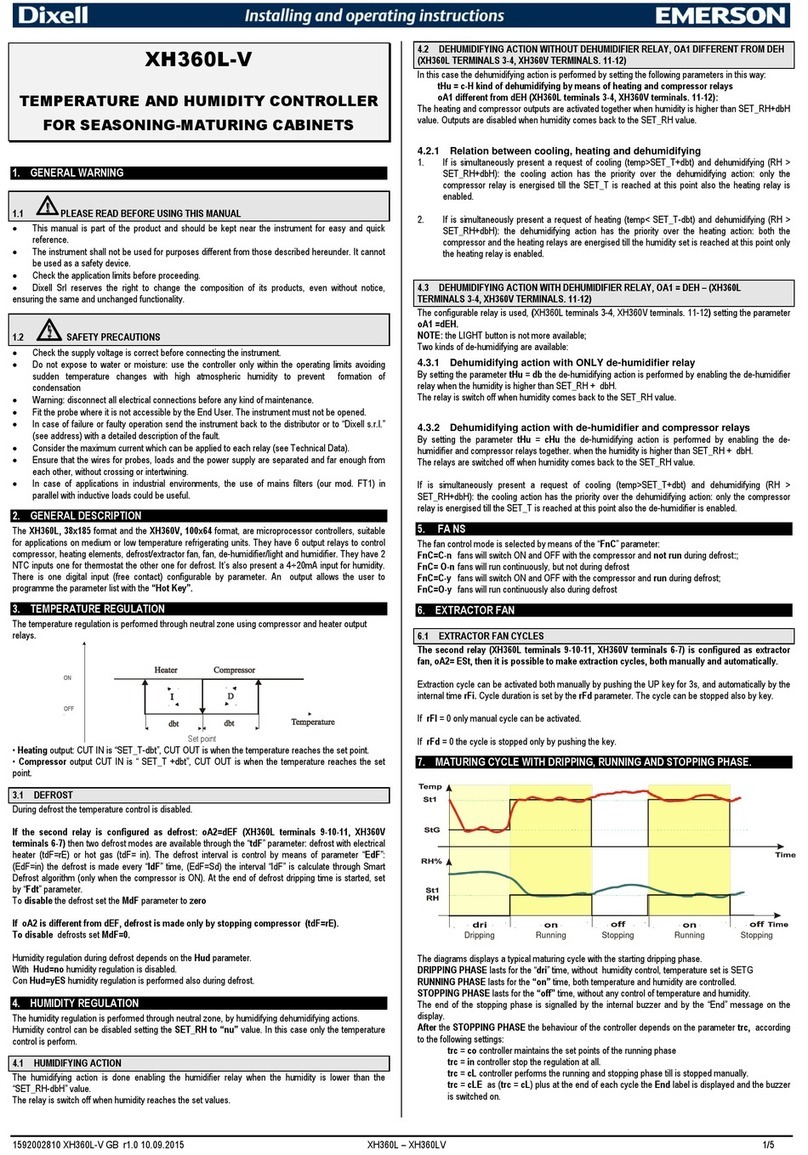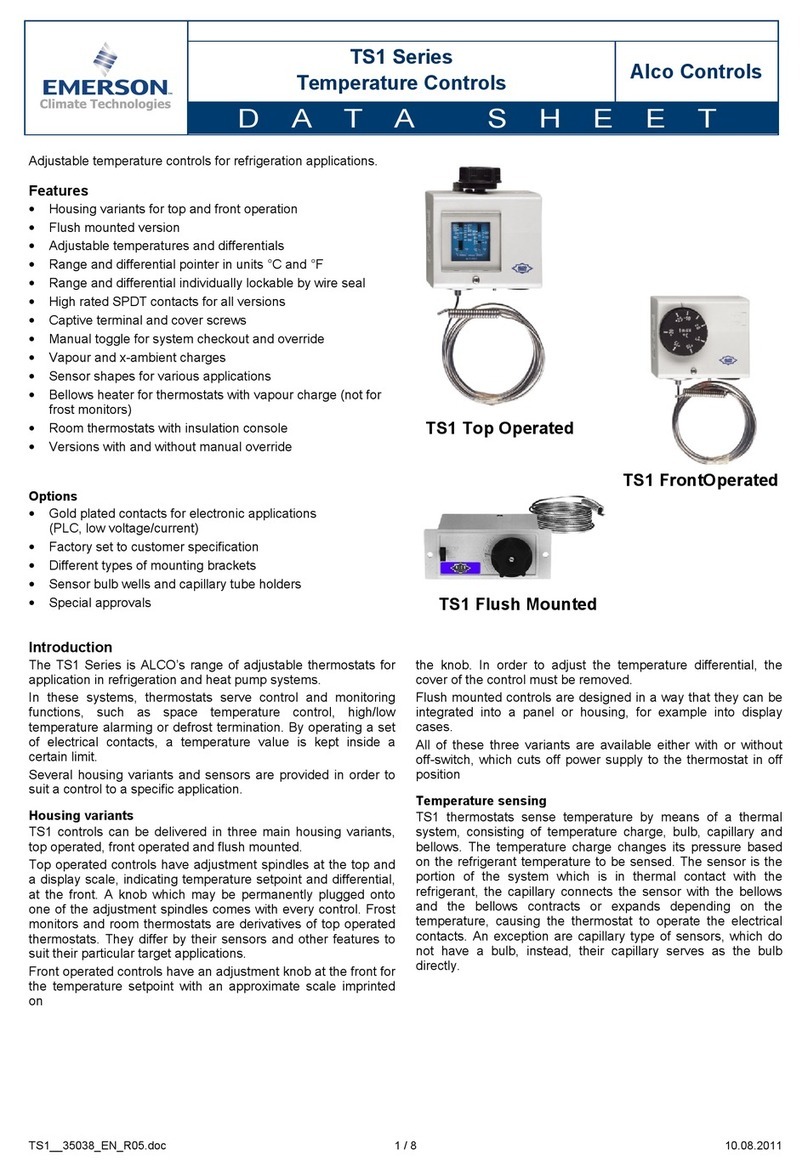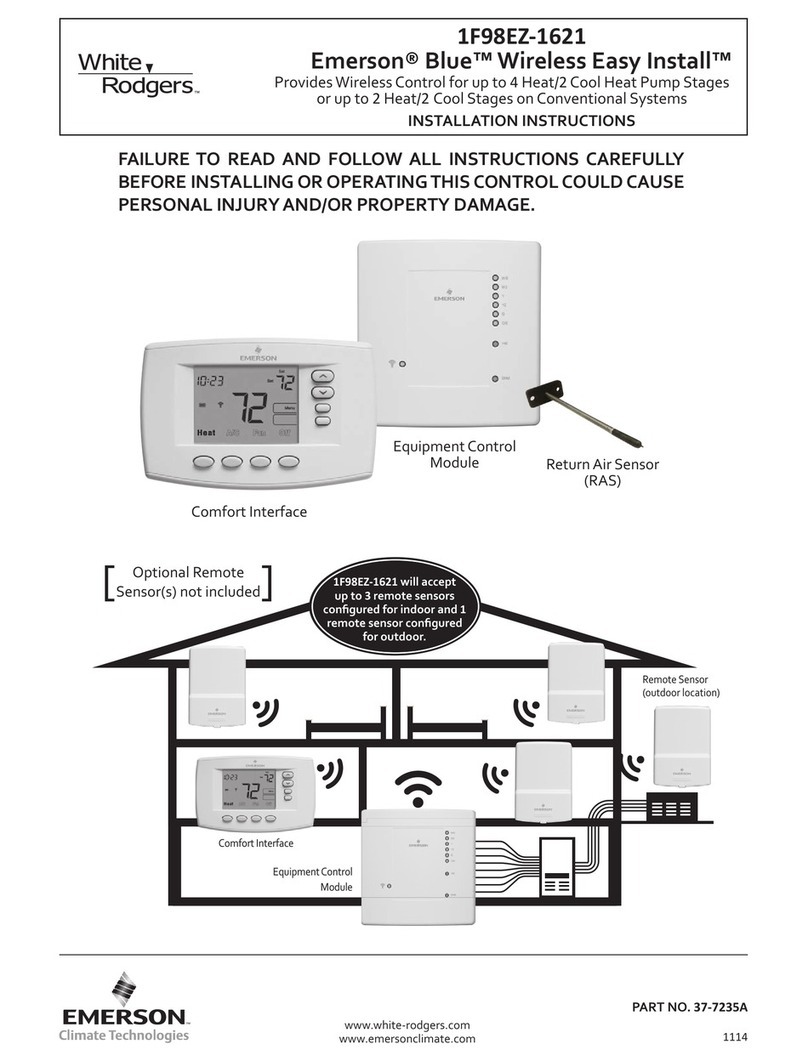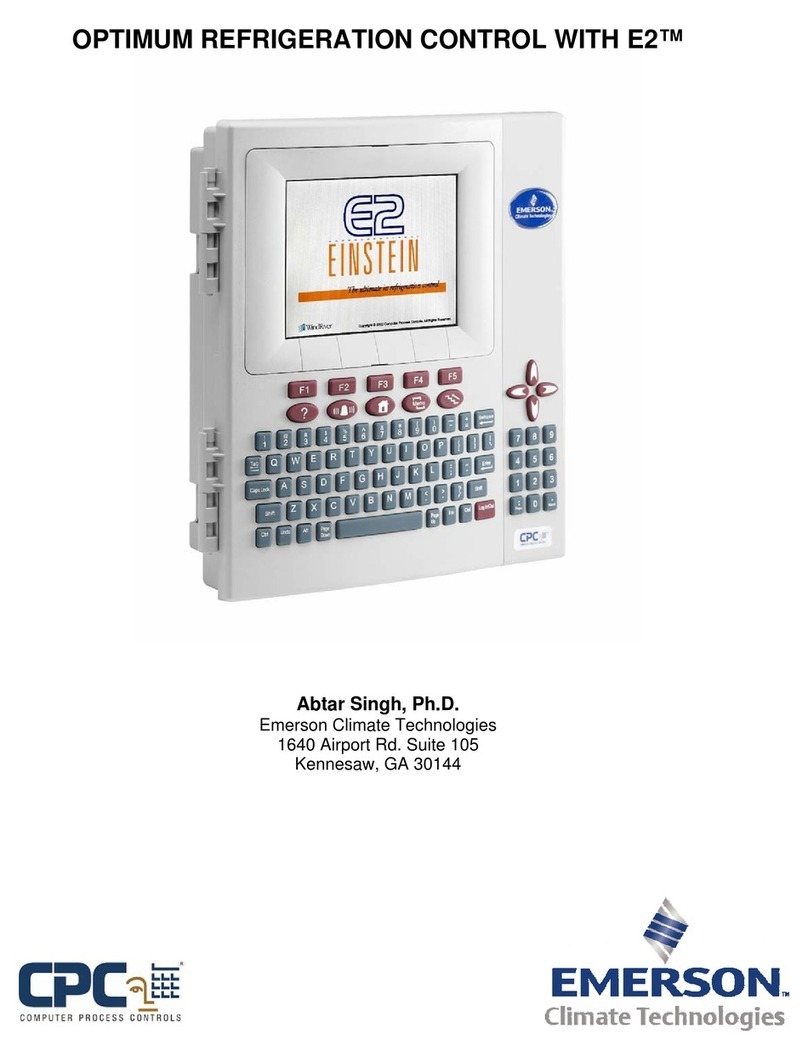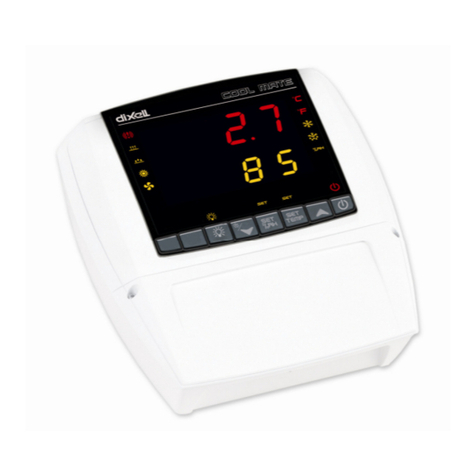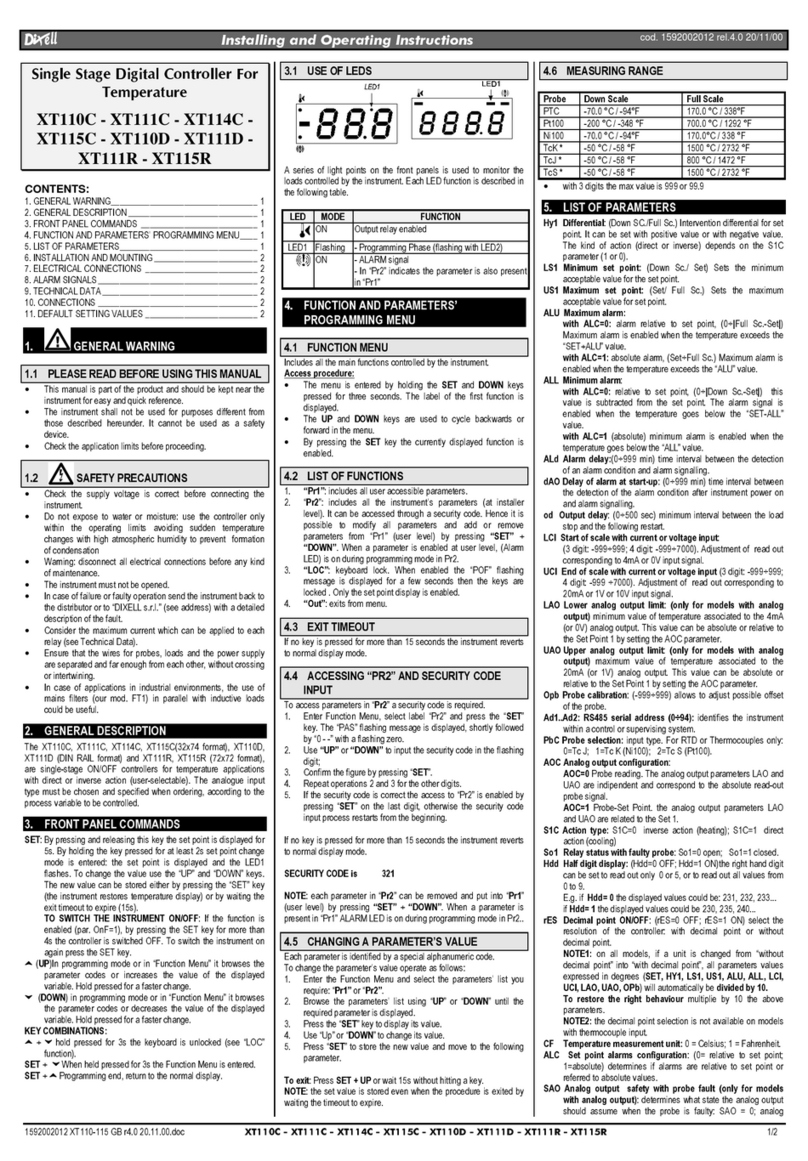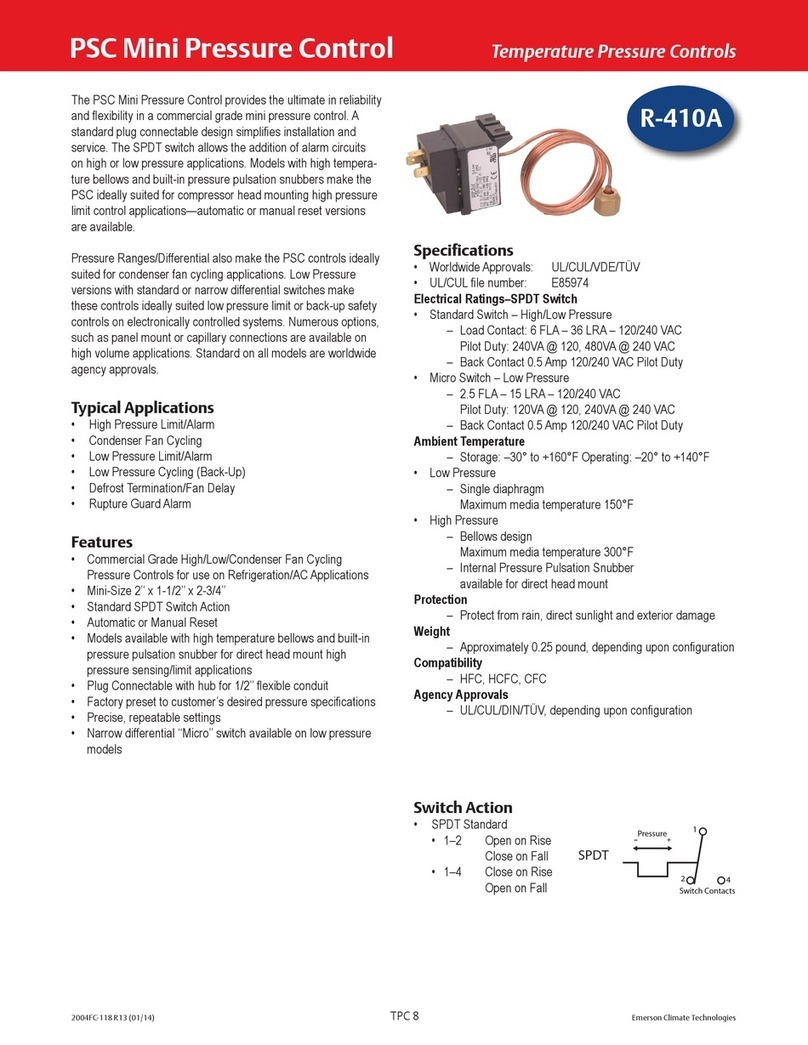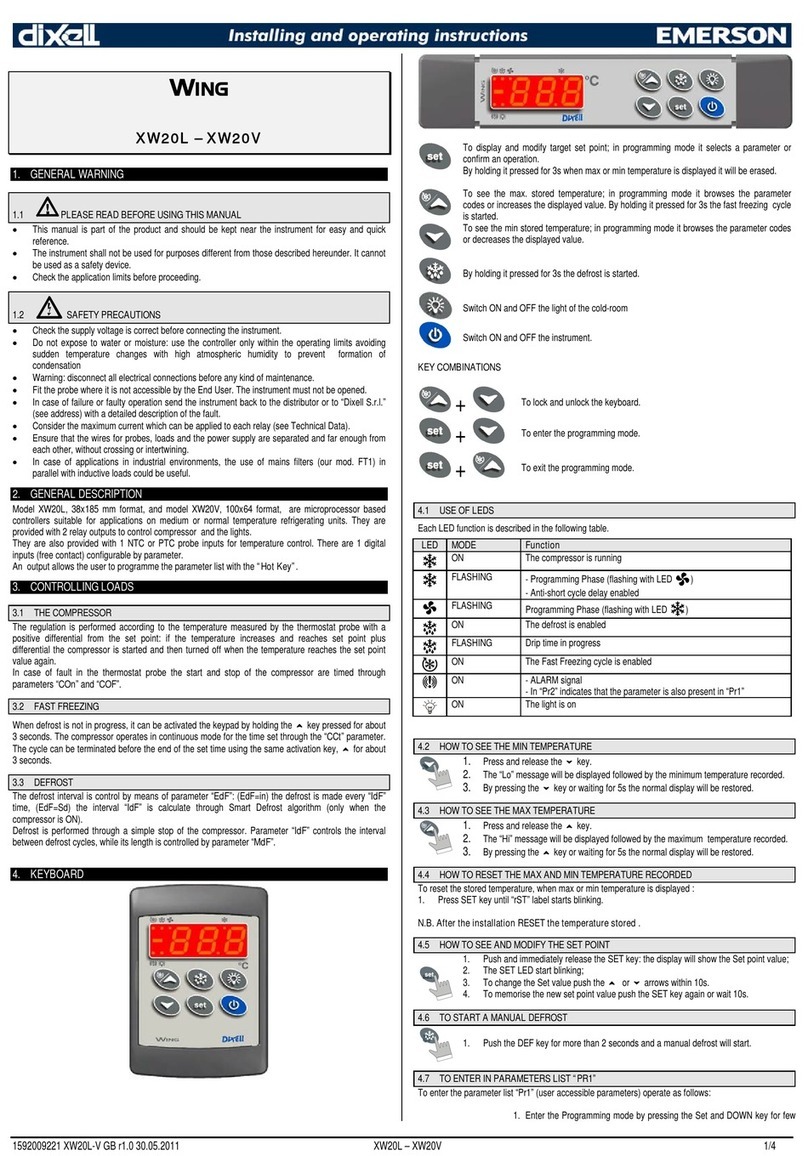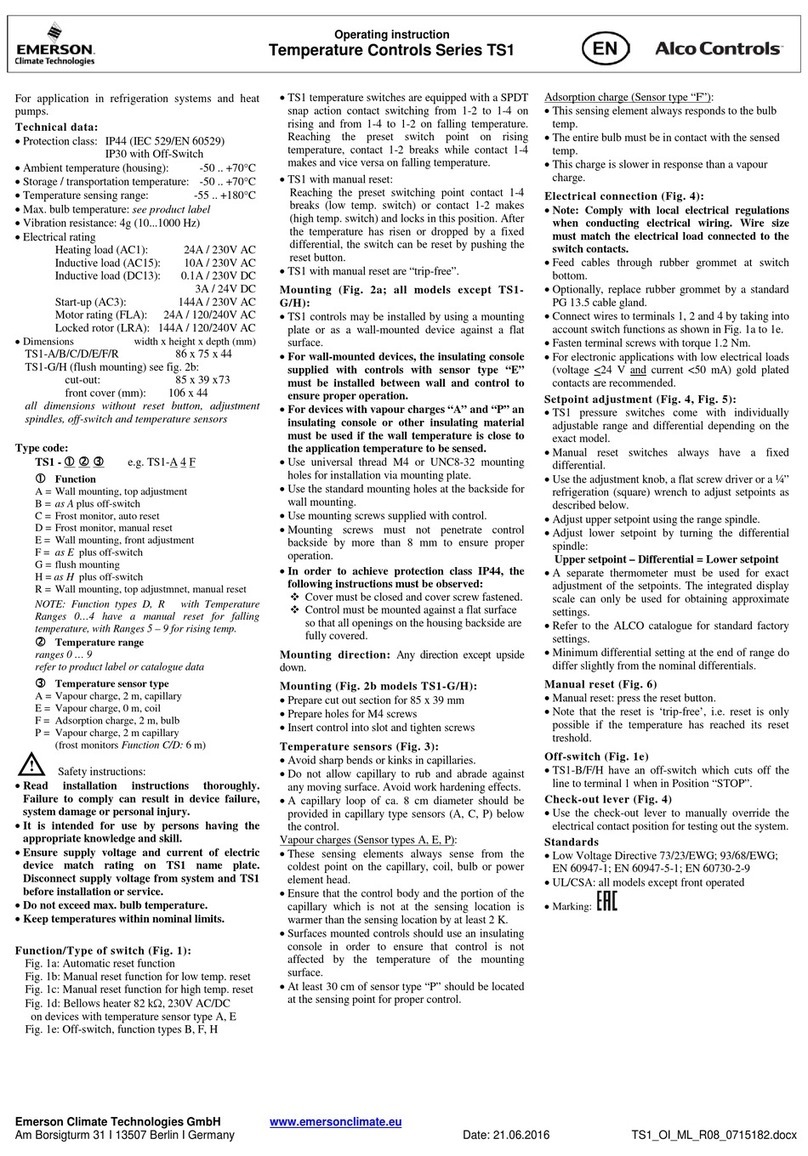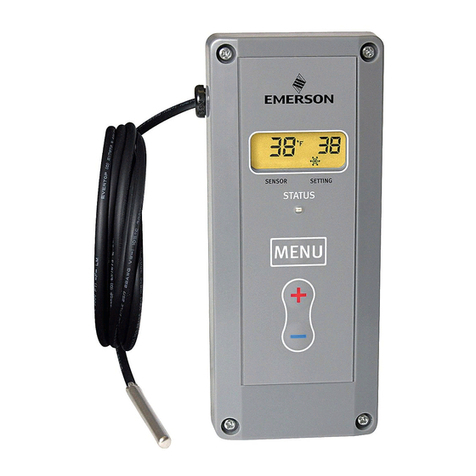
1592009730 XW30-35VS GB r1.2 31.07.2015 XW30VS - XW35VS 2/4
4.5 HOW TO SEE AND MODIFY THE SET POINT
1. Push and immediately release the SET key: the display will show the Set point value;
2. The SET LED start blinking;
3. To change the Set value push the o or narrows within 10s.
4. To memorise the new set point value push the SET key again or wait 10s.
4.6 TO START A MANUAL DEFROST
1. Push the DEF key for more than 2 seconds and a manual defrost will start.
4.7 TO ENTER IN PARAMETERS LIST “PR1”
To enter the parameter list “Pr1” (user accessible parameters) operate as follows:
1. Enter the Programming mode by pressing the Set and DOWN key for few
seconds ( and start blinking).
2. The instrument will show the first parameter present in “Pr1”
4.8 TO ENTER IN PARAMETERS LIST “PR2”
To access parameters in “Pr2”:
1. Enter the “Pr1” level.
2. Select “Pr2” parameter and press the “SET” key.
3. The “PAS” flashing message is displayed, shortly followed by “0 - -” with a flashing zero.
4. Use oor nto input the security code in the flashing digit; confirm the figure by pressing “SET”.
The security code is “321“.
5. If the security code is correct the access to “Pr2” is enabled by pressing “SET” on the last digit.
Another possibility is the following: after switching ON the instrument the user can push Set and DOWN
keys within 30 seconds.
NOTE: each parameter in “Pr2” can be removed or put into “Pr1” (user level) by pressing “SET” + n.
When a parameter is present in “Pr1” LED is on.
4.9 HOW TO CHANGE THE PARAMETER VALUE
1. Enter the Programming mode.
2. Select the required parameter with oor n.
3. Press the “SET” key to display its value ( and LED starts blinking).
4. Use oor nto change its value.
5. Press “SET” to store the new value and move to the following parameter.
To exit: Press SET + UP or wait 15s without pressing a key.
NOTE: the new programming is stored even when the procedure is exited by waiting the time-out.
4.10 HOW TO LOCK THE KEYBOARD
1. Keep the oand nkeys pressed together for more than 3 s the oand nkeys.
2. The “POF” message will be displayed and the keyboard is locked. At this point it is
only possible the viewing of the set point or the MAX o Min temperature stored and
to switch ON and OFF the light, the auxiliary output and the instrument.
TO UNLOCK THE KEYBOARD
Keep the oand nkeys pressed together for more than 3s.
4.11 ON/OFF FUNCTION
By pushing the ON/OFF key, the instrument shows “OFF” for 5 sec. and the ON/OFF
LED is switched ON.
During the OFF status, all the relays are switched OFF and the regulations are stopped;
N.B. During the OFF status the Light button is active.
4.12 TO SEE THE PROBE VALUES
1. Enter in “Pr2” level.
2. Select “Prd” parameter with oor n.
3. Press the “SET” key to display “Pb1” label alternate with Pb1 value.
4. Use o and nkeys to display the other probe values.
5. Press “SET” to move to the following parameter.
5. PARAMETER LIST
REGULATION
Hy Differential: (0,1÷25,5°C; 1÷45°F): Intervention differential for set point, always positive.
Compressor Cut IN is Set Point Plus Differential (Hy). Compressor Cut OUT is when the
temperature reaches the set point.
LS Minimum set point limit: (-50,0°C
SET; -58°F÷SET) Sets the minimum acceptable value for
the set point.
US Maximum set point limit: (SET
110°C; SET÷230°F) Set the maximum acceptable value for set
point.
OdS Outputs activation delay at start up: (0÷255 min) This function is enabled at the initial start up
of the instrument and inhibits any output activation for the period of time set in the parameter.
(Light can work)
AC Anti-short cycle delay: (0÷30 min) interval between the compressor stop and the following
restart.
CCt Thermostat override: (0min ÷23h 50min) allows to set the length of the continuous cycle. Can
be used, for instance, when the room is filled with new products.
Con Compressor ON time with faulty probe: (0÷255 min) time during which the compressor is active
in case of faulty thermostat probe. With COn=0 compressor is always OFF.
COF Compressor OFF time with faulty probe: (0÷255 min) time during which the compressor is off
in case of faulty thermostat probe. With COF=0 compressor is always active.
CH Type of action: CL = cooling; Ht = heating.
DISPLAY
CF Temperature measurement unit: °C = Celsius; °F = Fahrenheit. When the measurement unit is
changed the SET point and the values of some parameters have to be modified.
rES Resolution (for °C): (in = 1°C; de = 0,1°C) allows decimal point display.
dE = 0,1°C; in = 1 °C
Lod Local display : select which probe is displayed by the instrument:
P1 = Thermostat probe; P3 = Display probe; P2: not set it, 1r2: not set it
DEFROST
EdF Defrost mode:
in = interval mode. The defrost starts when the time “Idf” is expired.
Sd = Smartfrost mode. The time IdF (interval between defrosts) is increased only when the
compressor is running (even non consecutively) and only if the evaporator temperature is less
than the value in "SdF” (set point for SMARTFROST).
IdF Interval between defrosts: (1÷120h) Determines the time interval between the beginning of two
defrost cycles.
MdF (Maximum) duration of defrost: (0÷255 min) When P2P = n, no evaporator probe, it sets the
defrost duration, when P2P = y, defrost end based on temperature, it sets the maximum length for
defrost.
dFd Display during defrost:
rt = real temperature; it = temperature reading at the defrost start;
Set = set point; dEF = “dEF” label; dEG = “dEG” label;
dAd Defrost display time out: (0
255 min) Sets the maximum time between the end of defrost and
the restarting of the real room temperature display.
dPO First defrost after start-up:
y = Immediately; n= after the IdF time
dAF Defrost delay after fast freezing: (0min÷23h 50min) after a Fast Freezing cycle, the first defrost
will be delayed for this time.
FANS –Only for XR35VS
FnC Fan operating mode:
C-n = running with the compressor, OFF during the defrost;
C-y = running with the compressor, ON during the defrost;
O-n = continuous mode, OFF during the defrost;
O-y = continuous mode, ON during the defrost;
Fnd Fan delay after defrost: (0÷255 min) The time interval between the defrost end and evaporator
fans start.
ALARMS
ALC Temperature alarm configuration
rE = High and Low alarms related to Set Point
Ab = High and low alarms related to the absolute temperature.
ALU High temperature alarm setting:
ALC= rE, 0
50°C or 90°F
ALC= Ab, ALL
110°C or 230°F
when this temperature is reached and after the ALd delay time the HA alarm is enabled.
ALL Low temperature alarm setting:
ALC = rE , 0
50 °C or 90°F
ALC = Ab , - 50°C or -58°F
ALU
when this temperature is reached and after the ALd delay time, the LA alarm is enabled,.
AFH Temperature alarm differential: (0,1÷25,5°C; 1÷45°F) Intervention differential for temperature
alarm set point, always positive.
ALd Temperature alarm delay: (0÷255 min) time interval between the detection of an alarm condition
and the corresponding alarm signalling.
dAO Delay of temperature alarm at start-up: (0min÷23h 50min) time interval between the detection
of the temperature alarm condition after the instrument power on and the alarm signalling.
EdA Alarm delay at the end of defrost: (0
255 min) Time interval between the detection of the
temperature alarm condition at the end of defrost and the alarm signalling.
dot Delay of temperature alarm after closing the door : (0
255 min) Time delay to signal the
temperature alarm condition after closing the door.
doA Open door alarm delay:(0÷255 min) delay between the detection of the open door condition and
its alarm signalling: the flashing message “dA” is displayed.
nPS Pressure switch number: (0
15) Number of activation of the pressure switch, during the “did”
interval, before signalling the alarm event (I2F= PAL).
If the nPS activation in the did time is reached, switch off and on the instrument to restart
normal regulation.
PROBE INPUTS
Ot Thermostat probe calibration: (-12.0
12.0°C/ -21
21°F) allows to adjust possible offset of the
thermostat probe.
O3 Display probe calibration: (-12.0
12.0°C/ -21
21°F) allows to adjust possible offsets of the
display probe.
P3P Display probe presence: n= not present:; y= present:.
HES Temperature increase during the Energy Saving cycle : (-30,0°C
30,0°C / -22÷86°F) sets
the increasing value of the set point during the Energy Saving cycle.
DIGITAL INPUTS
odc Compressor and fan status when open door:
no = normal; Fan = Fan OFF; CPr = Compressor OFF; F_C = Compressor and fan OFF.
I2P Configurable digital input polarity:
CL : the digital input is activated by closing the contact;
OP : the digital input is activated by opening the contact
I2F Digital input operating mode: configure the digital input function:
EAL = generic alarm; bAL = serious alarm mode; PAL = Pressure switch; dFr = Start
defrost;
AUS = Not used; Es = Energy Saving; onF = remote On/OFF; dor = door switch
did Time interval/delay for digital input alarm:(0
255 min.) If I2F=EAL or bAL (external alarms),
“did” parameter defines the time delay between the detection and the successive signalling of the
alarm.
